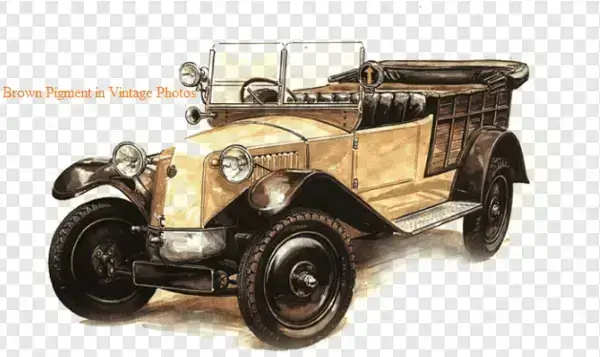Vintage photos have a unique charm that evokes nostalgia and a sense of history. One of the most iconic features of these photos is the brown pigment in vintage photos that often colors them, adding warmth and a timeless quality. This distinctive hue, commonly known as sepia tone, not only enhances the aesthetic appeal of vintage photographs but also preserves their historical essence. In this article, we will explore the origins of the brown pigment in vintage photos, its cultural significance, and ways to recreate this classic look in modern photography.
The History of Brown Pigment in Old Photographs
Below are the findings of the research depicting that the use of brown pigment in vintage photos started in the 19th century. From the daguerreotype to the calotype, the photographs were manifest in various shades of brown because of the chemical processes that went into making the photos. The sepia tone, often derived from the cuttlefish ink got its name and was fashionable in the late 1800s and the early 1900s.
- Chemical Process and Preservation: The brown pigment contrasting the white of the dress was not only beautiful but also functional. The sepia toning that was done in an endeavor to replace the photograph metallic silver with a less likely-to-fade silver sulfide was equally helpful in the preservation process. This made them more resilient from fading and declining with time, and this enabled passerby who took these pictures to tell their stories for generations.
- Cultural and Artistic Impact: The sepia tone quickly became a cultural icon, symbolizing an era of transition from the traditional to the modern. It evoked a sense of nostalgia and romance, often associated with the Victorian era’s fascination with antiquity and the passage of time. Photographers and artists embraced this style, using the brown pigment to add depth and emotion to their work.
The Significance of brown pigment in vintage photos
The brown pigment in vintage photos is more than just a stylistic choice; it carries deep cultural and emotional significance.
- Evoking Nostalgia: The sepia tone has the power to transport viewers to a bygone era. It creates a warm, nostalgic atmosphere that reminds us of the passage of time and the changes that have occurred. This connection to the past is a key reason why vintage photos with brown pigment are cherished by collectors and history enthusiasts alike.
- Symbolism and Emotion: Brown pigment in vintage photos often symbolizes warmth, comfort, and intimacy. It can evoke emotions of longing and reminiscence, making these photos powerful storytelling tools. The soft, muted tones of sepia can also highlight the contrast between light and shadow, adding a dramatic flair to the images.
- Timeless Aesthetic: The sepia tone’s timeless appeal makes vintage photos with brown pigment stand out in a digital age dominated by high-definition color imagery. This aesthetic has inspired contemporary photographers to experiment with sepia and other monochromatic tones, bridging the gap between past and present.
Achieving the Brown Pigment Effect in Modern Photography
While the brown pigment effect in vintage photos was originally a result of chemical processes, modern photographers can easily recreate this look using digital tools.
- Digital Filters and Editing Software: Today, photographers can use digital filters and editing software like Adobe Photoshop and Lightroom to apply sepia tones to their images. These tools offer precise control over the intensity and shade of the brown pigment, allowing photographers to achieve the perfect vintage look.
- Film Photography Techniques: For those who prefer a more authentic approach, traditional film photography techniques can be used to produce images with brown pigment. This includes using sepia-toned film or applying sepia toner during the developing process.
- Creative Applications: The brown pigment effect can be used creatively to enhance various types of photography, from portraits to landscapes. It can add a sense of history and depth to modern images, making them feel timeless and evocative.
FAQs About brown pigment in vintage photos
- What causes the brown pigment in vintage photos?
The brown pigment, commonly known as sepia tone, is caused by the chemical process of replacing metallic silver with silver sulfide in the photographic emulsion. This process not only gives the photos their distinctive hue but also helps preserve them.
- How does sepia toning affect the longevity of photos?
Sepia toning stabilizes the silver compounds in the photographic emulsion, making the photos more resistant to fading and deterioration. This increased durability has helped vintage photos survive for many decades.
- Can I create the brown pigment effect with digital photos?
Yes, digital photo editing software like Photoshop and Lightroom offers sepia filters and adjustments that can replicate the brown pigment effect. These tools allow for precise control over the tone and intensity of the sepia effect.
- What are some popular uses of the brown pigment effect in modern photography?
The brown pigment effect is popular in portrait and wedding photography for its warm, nostalgic feel. It is also used in fine art photography to evoke a vintage or timeless aesthetic.
- Is the sepia tone used exclusively for black-and-white photos?
While the sepia tone is traditionally associated with black-and-white photos, it can also be applied to color images to create a unique, vintage-inspired look.
Conclusion
The brown pigment in vintage photos, or sepia tone, is more than just a color; it’s a portal to the past, a symbol of nostalgia, and a timeless artistic choice. Whether you’re a photographer looking to add a vintage touch to your work or a history enthusiast fascinated by the stories these photos tell, the sepia tone continues to captivate and inspire. By understanding its origins, significance, and methods of recreation, we can appreciate the enduring appeal of brown pigment in vintage photos and continue to keep this classic aesthetic alive in modern photography.
